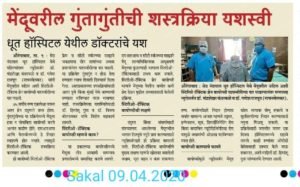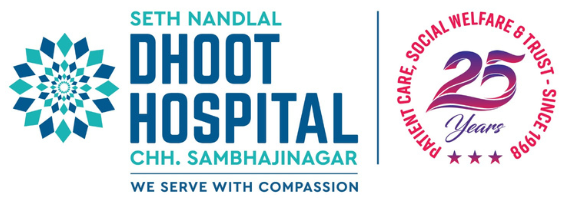Sterio tactic Brain Biopsy was successfully done in Seth Nandlal Dhoot Hospital for the first time by Dr. Chandrashekhar Kandarphale and Dr. Ganesh Harishchandra Rajput. Both are the Neurosurgeon in the same Hospital.
Patient was 75 yr male suffering from multiple brain tumors, it was deep-seated in the eloquent area of the brain which was difficult to approach without complications. MRI and PET CT was not able to clearly delineate the diagnosis. Considering deep-seated Lesion and 75 yr he was opted put for Sterio-tactic brain biopsy surgery.
His procedure was done with the help of Sterio-tactic frame and CT scan. It took 2 hrs to complete the procedure. The patient was discharged on the same day without any complication.
Now regional patient does not have to go to Pune and Mumbai for this kind of surgery, it will available in Dhoot hospital.
The team had great support of Dr. Gupta and Dr. Borgaokar.

About STB-
Stereotactic neurosurgery or biopsy involves mapping the brain in a three-dimensional coordinate system. With the help of MRI and CT scans, neurosurgeons are able to accurately target any area of the brain in stereotactic space (3D coordinate system).
Stereotactic brain biopsy is a minimally invasive procedure that uses this technology to obtain samples of brain tissue for diagnostic purposes.
Indications
This procedure is used by neurosurgeons to obtain tissue samples of areas within the brain that are suspicious for tumors or infections. The main indications for stereotactic biopsy are deep-seated lesions, multiple lesions, or lesions in a surgically poor candidate who cannot tolerate anesthesia.
The most common ailments that may be diagnosed by a biopsy are tumors, infection (e.g. abscess), inflammation (e.g. encephalitis), demyelineting diseases (e.g. multiple sclerosis) or perhaps neurodegenerative diseases (e.g. Alzheimer’s disease). The biopsy may help identify lesions that do not require surgical treatment or diagnose patients who are poor surgical candidates so they can pursue other appropriate therapies.
Benefits
A needle biopsy makes it possible for neurosurgeons to reach the deepest recesses of the brain, allowing them to obtain a specimen in order to make a diagnosis in a relatively safe manner. Hospitalization is short and, at most, requires an overnight stay. Some patients are treated on an outpatient basis.



